A Study of the Dynamic Evolution Game of Cooperative Management by Multiple Subjects Under the Forest Ticket System
Abstract
1. Introduction
2. Theoretical Analysis and Model Setting
2.1. Theoretical Foundation
2.1.1. Stakeholder Theory
2.1.2. Evolutionary Game Theory
2.2. Analytical Framework
2.3. Research Area and Model Setting
2.3.1. Selection of the Research Area
2.3.2. Model Assumption
2.3.3. Model Construction
3. Results
3.1. Results of the Game Model
3.1.1. Analysis of Evolutionary Stabilisation Strategies of State-Owned Forestry Farms
3.1.2. Analysis of Evolutionary Stabilisation Strategies of Village Collective Economic Organisations
3.1.3. Analysis of Evolutionary Stabilisation Strategies of Individual Forest Farmers
3.1.4. Stability Analysis of Equilibrium Points of Tripartite Evolutionary Game Systems
3.2. Simulation Analysis Results
3.2.1. Effects of Changes in Initial Probability
3.2.2. Simulation Results for the Forest Business Environment
3.2.3. Simulation Results for the Level of Inputs to State-Owned Forest Farms
3.2.4. Simulation Results for Village Collective Economic Organisations’ Participation Costs
3.2.5. Simulation Results for the Degree of Participation of Individual Foresters and the Impact of Forest Ticket Transaction Benefits
4. Discussion
5. Conclusions and Recommendations
5.1. Conclusions
- (1)
- The long-term sustainable operation of the forest ticket system requires the collaborative participation of multiple stakeholders, and the three stakeholder groups will influence each other’s strategy choices in the game process. Under certain conditions, the three subjects can achieve three stable equilibrium strategies—(0,1,0), (0,1,1) and (1,1,1). Among them, (1,1,1), i.e., a high level of input from state-owned forest farms, participation of village collective economic organisations, and high willingness of individual foresters to participate, is the most realistic and ideal scenario.
- (2)
- The degree of recognition and participation of each subject in the forest ticket system helps to promote the three parties to reach the optimal equilibrium strategy. When the degree of information asymmetry is significantly reduced, the flow of information between participating subjects is more transparent. At this time, the flow of information among the subjects is smoother and the degree of access to information is similar. State-owned forest farms can formulate a good management strategy and increase the investment in forestry by playing their professional advantages. Village collective economic organizations can actively play the role of a link to build a good bridge of communication. Individual foresters have a high level of trust in the co-operative partners and model, and the risk of default on deforestation is reduced. Therefore, breaking down information barriers can effectively reach a win–win situation in multi-party collaboration and promote the orderly operation of the forest ticket system.
- (3)
- The development of the forest management environment and market environment to good or bad will significantly affect the behavioural decision-making and the formation of cooperation equilibrium of each subject. When the market operating environment is expected to develop favourably, state-owned forest farms and individual foresters are more inclined to participate in cooperation with high input and a high willingness to promote the rapid achievement of cooperation. Conversely, there are more challenges to achieving cooperation. Therefore, optimising the cooperation mechanism, improving the risk protection mechanism, and enhancing the ability to withstand market fluctuations are crucial to promote the sustainable development of forest land cooperation.
- (4)
- Changes in the costs and benefits of cooperative forest management are closely related to the decision-making choices of each subject. State-owned forest farms, as the leading party of forest land cooperation, are particularly sensitive to changes in the cost–benefit ratio. When the marginal return brought by the input level decreases, the state-owned forest farms tend to reduce inputs and lower input levels, thus falling into the vicious circle of ‘lower input levels–lower marginal returns–lower operating incentives–lower input levels’. Therefore, improving management efficiency and controlling the ratio of income to cost is an important means to promote forest land cooperation.
- (5)
- The tradable and pledge characteristics of the forest ticket provide individual foresters with a way to increase their income beyond the income from forest land, effectively motivating individual foresters to actively participate in cooperative forest land management. The higher the degree of participation and willingness of individual foresters, the greater the possibility of obtaining additional economic benefits through the transfer of forest tickets and financial pledges, thus improving the overall level of returns.
5.2. Research Limitations and Prospects
- (1)
- In today’s academic research field, the methodology of evolutionary game models is undergoing rapid changes and development. Cutting-edge research methods such as stochastic evolutionary models and fractional order models are gradually and widely introduced into the analysis of evolutionary games, injecting new vitality and ideas into the research in this field. However, we must honestly admit that there is still a gap between the methodologies used in our research work and the most advanced and exquisite research methods in the international arena, which requires us to make continuous efforts to catch up and improve. We have collated the similarities and differences between SOTA and this research work below.
- (2)
- Based on the information and data from visits and interviews with representatives of forestry government departments, forestry enterprises and institutions, village collective economic organisations, and forest farmers in the Sanming region of Fujian, the generalisability of the research results may be limited.
- (3)
- Because the forest ticket system is still a new thing in China’s forestry sustainable management policy system, the information available on the revenue of forest land cooperation is limited, and the current study discusses the theoretical level and the institutional level, but the analysis of the micro level needs to be improved.
- (4)
- According to the existing policies and documents of the forest ticket system, the government departments only play the role of encouraging and supervising, and do not actually participate in the specific cooperative management and the process of forest ticket distribution. Therefore, this study focused on state-owned forest farms, village collective economic organisations, and forest farmers. However, with the continuous improvement of the forest ticket system, it is not yet known how the role of government departments will change in the future. Future research should follow the adjustment and implementation of the policy, and explore the impact of the forest ticket system on the sustainable management of China’s forestry industry in more depth so as to enrich our understanding of this innovative forestry management system.
Author Contributions
Funding
Data Availability Statement
Acknowledgments
Conflicts of Interest
References
- Min, S.; Lee, H.; Son, J.; Park, M.S. Structural Policy Coordination for Forest Ecosystem Services Management in the Legal Accountability System. For. Policy Econ. 2024, 166, 103282. [Google Scholar] [CrossRef]
- Das, R.C.; Chatterjee, T.; Ivaldi, E. Co-Movements of Income and Urbanization through Energy Use and Pollution: An Investigation for World’s Leading Polluting Countries. Ecol. Indic. 2023, 153, 110381. [Google Scholar] [CrossRef]
- Appiah, M.; Li, M.; Taden, J.; Ashraf, S.; Tiwari, A.K.; Laari, P.B. Enhancing Natural Resource Rents through Industrialization, Technological Innovation, and Foreign Capital in the OECD Countries: Does Financial Development Matter? Resour. Policy 2024, 89, 104520. [Google Scholar] [CrossRef]
- Saravia-Maldonado, S.A.; Fernández-Pozo, L.F.; Ramírez-Rosario, B.; Rodríguez-González, M.Á. Analysis of Deforestation and Water Quality in the Talgua River Watershed (Honduras): Ecosystem Approach Based on the DPSIR Model. Sustainability 2024, 16, 5034. [Google Scholar] [CrossRef]
- Ayoo, C. Economic Determinants of Deforestation in Developing Countries. Int. J. Environ. Sustain. Dev. 2022, 21, 285. [Google Scholar] [CrossRef]
- Smith, A.C.; Hajjar, R.; Kanel, K.R.; Fox, J.; Tuladhar, S.; Van Den Hoek, J. Out-Migration, Agricultural Abandonment, and Community Forest Management: Drivers of Afforestation in Privately Managed Land in Nepal. Appl. Geogr. 2024, 167, 103275. [Google Scholar] [CrossRef]
- Frei, T.; Edou, K.; Rodríguez Fernández-Blanco, C.; Winkel, G. Governing Abandoned Land: Storylines on Natural Forest Regrowth in France and Spain. Environ. Sci. Policy 2022, 135, 58–66. [Google Scholar] [CrossRef]
- FAO. Global Forest Resources Assessment 2020; Food and Agriculture Organization of the United Nations: Rome, Italy, 2021; ISBN 978-92-5-134155-1. [Google Scholar]
- Keenan, R.J.; Reams, G.A.; Achard, F.; de Freitas, J.V.; Grainger, A.; Lindquist, E. Dynamics of Global Forest Area: Results from the FAO Global Forest Resources Assessment 2015. For. Ecol. Manag. 2015, 352, 9–20. [Google Scholar] [CrossRef]
- United Nations. United Nations Forest Instrument. 2018. Available online: https://www.un.org/esa/forests/wp-content/uploads/2018/08/UN_Forest_Instrument.pdf (accessed on 18 November 2024).
- Kauppi, P.E.; Sandström, V.; Lipponen, A. Forest Resources of Nations in Relation to Human Well-Being. PLoS ONE 2018, 13, e0196248. [Google Scholar] [CrossRef]
- Lu, S.; Sun, H.; Zhou, Y.; Qin, F.; Guan, X. Examining the Impact of Forestry Policy on Poor and Non-Poor Farmers’ Income and Production Input in Collective Forest Areas in China. J. Clean. Prod. 2020, 276, 123784. [Google Scholar] [CrossRef]
- Kong, F.; Wang, L.; Shen, Y.; Xu, C.; Liao, W. Research frontiers of collective forestry system reform. For. Econ. Issues 2021, 41, 1–12. (In Chinese) [Google Scholar] [CrossRef]
- Zhu, S.; Liu, J.; Xu, H.; Li, L.; Yang, W. Has China’s New Round of Collective Forest Reforms Reduced Forest Fragmentation? A Case Study of the Beijing–Tianjin–Hebei Region. Int. J. Environ. Res. Public Health 2022, 19, 6183. [Google Scholar] [CrossRef]
- Liu, C.; Kang, Z.; Zhu, W.; Zhang, Y.; Wei, X.; Zhang, L. China’s reform of collective forestland tenure:new progresses since 2012 and stylized facts over the past 40 years. For. Econ. 2024, 46, 5–23. (In Chinese) [Google Scholar] [CrossRef]
- Sun, G.; Zhang, S.; Gao, J. The Impact of the Degree of Forestlands Fragmentation on the Forest Farmers’ Forests Management Inputs. For. Econ. Issues 2022, 42, 599–606. (In Chinese) [Google Scholar] [CrossRef]
- Wang, J.; Wang, Y. Effect of Collective Action on Rural Economic Development in China: Does Labour Outmigration Matter? Appl. Econ. 2024, 1–14. [Google Scholar] [CrossRef]
- Zhang, Z.; Huang, M. Aging, factor allocation and farmers’ collective forest plantation decisions. J. Agric. For. Econ. Manag. 2024, 23, 91–100. (In Chinese) [Google Scholar] [CrossRef]
- Zhang, X.; Zhang, C.; Zhang, Y. Mechanism and empirical analysis of income-generating effect of forest ticket reform in Sanming. Fujian For. Sci. Technol. 2022, 49, 134–140. (In Chinese) [Google Scholar] [CrossRef]
- Krul, K.; Ho, P.; Yang, X. Incentivizing Household Forest Management in China’s Forest Reform: Limitations to Rights-Based Approaches in Southwest China. For. Policy Econ. 2020, 111, 102075. [Google Scholar] [CrossRef]
- Qiao, Q.; Lin, Z.; Sun, Z.; Zhang, W.; Zhang, M.; Sun, Y.; Gao, X. Multi-Stakeholder Game Relationships in Promoting the Development of the Non-Timber Forest Product Industry by State-Owned Forest Farms. Forests 2024, 15, 2049. [Google Scholar] [CrossRef]
- Yang, G.; Wang, H.; Hou, Y.; Jiang, X.; Hu, M. The Impact of Collective Forest Tenure Reform on Timber Production in China: An Empirical Analysis Based on Provincial Panel Data. Forests 2024, 15, 312. [Google Scholar] [CrossRef]
- He, J.; Kebede, B.; Martin, A.; Gross-Camp, N. Privatization or Communalization: A Multi-Level Analysis of Changes in Forest Property Regimes in China. Ecol. Econ. 2020, 174, 106629. [Google Scholar] [CrossRef]
- Dong, J.; Liang, W.; Fu, Y.; Liu, W.; Managi, S. Impact of Devolved Forest Tenure Reform on Formal Credit Access for Households: Evidence from Fujian, China. Econ. Anal. Policy 2021, 71, 486–498. [Google Scholar] [CrossRef]
- Song, B.; Han, X.; Lv, S.; Fang, Q.; Wang, Z.; Li, H. What Affects the Willingness of Farmers to Participate in Forest Ticket Trading? Empirical Analysis Based on Incomplete Information Theory. Forest 2024, 15, 821. [Google Scholar] [CrossRef]
- Chen, R.; Chen, W.; Hu, M.; Huang, W. Measuring Improvement of Economic Condition in State-Owned Forest Farms’ in China. Sustainability 2020, 12, 1593. [Google Scholar] [CrossRef]
- McGinley, K.A.; Gould, W.A.; Álvarez-Berríos, N.L.; Holupchinski, E.; Díaz-Camacho, T. READY OR NOT? Hurricane Pre-paredness, Response, and Recovery of Farms, Forests, and Rural Communities in the U.S. Caribbean. Int. J. Disaster Risk Reduct. 2022, 82, 103346. [Google Scholar] [CrossRef]
- Yiwen, Z.; Kant, S.; Long, H. Collective Action Dilemma after China’s Forest Tenure Reform: Operationalizing Forest Devo-lution in a Rapidly Changing Society. Land 2020, 9, 58. [Google Scholar] [CrossRef]
- Fang, Q.; Li, H.; Xie, Y. Forest Ticket Practice: The Way to Realize the Capitalization of Collective Forest Resources. J. Beijing For. Univ. (Soc. Sci. Ed.) 2022, 21, 55–62. (In Chinese) [Google Scholar] [CrossRef]
- Hogarth, N.J.; Belcher, B.; Campbell, B.; Stacey, N. The Role of Forest-Related Income in Household Economies and Rural Livelihoods in the Border-Region of Southern China. World Dev. 2013, 43, 111–123. [Google Scholar] [CrossRef]
- Zhang, X.; Zhang, Y.; Zhang, C. Research on forest ticket system—Based on the ‘Four Together’ forestry co-operation model. China For. Econ. 2021, 3, 26–30. (In Chinese) [Google Scholar] [CrossRef]
- Gao, S. Research on the Interest Relationship and Coordination Between Provincial State-Owned Forest Farms and Communities in Sanming City; Beijing Forestry University: Beijing, China, 2020. (In Chinese) [Google Scholar] [CrossRef]
- Li, J. SWOT analysis and strategic decision-making of forestry financial practices in Fujian Province. Taiwan Agric. Explor. 2023, 45, 68–75. (In Chinese) [Google Scholar] [CrossRef]
- Zhang, Y.; Zhang, X.; Mao, S.; Wen, J. Exploration of ‘State-owned Forestry Farm + X’ Forestry Co-operative Management Model--Taking Shaxian County of Fujian as an Example. J. Wuyi Coll. 2020, 39, 41–47. (In Chinese) [Google Scholar] [CrossRef]
- Freeman, R.E.; Dmytriyev, S.D.; Phillips, R.A. Stakeholder Theory and the Resource-Based View of the Firm. J. Manag. 2021, 47, 1757–1770. [Google Scholar] [CrossRef]
- Grimble, R.; Wellard, K. Stakeholder Methodologies in Natural Resource Management: A Review of Principles, Contexts, Experiences and Opportunities. Agric. Syst. 1997, 55, 173–193. [Google Scholar] [CrossRef]
- Neumann, J.L.V.; Morgenstern, O.V. The Theory of Games and Economic Behavior; Princeton University Press: Princeton, NJ, USA, 1972; ISBN OCLC:59855226. [Google Scholar]
- Tian, M.; Zheng, Y.; Sun, X.; Zheng, H. A Research on Promoting Chemical Fertiliser Reduction for Sustainable Agriculture Purposes: Evolutionary Game Analyses Involving ‘Government, Farmers, and Consumers’. Ecol. Indic. 2022, 144, 109433. [Google Scholar] [CrossRef]
- Qi, K.; Guo, X.; Guan, X.; Yang, Z. Evolutionary Game Analysis of Green Supply Chain Management Diffusion under Envi-ronmental Regulation. Sustainability 2024, 16, 3729. [Google Scholar] [CrossRef]
- Smith, J.M. Evolutionary Game Theory. Phys. D Nonlinear Phenom. 1986, 22, 43–49. [Google Scholar] [CrossRef]
- Easley, D.; Kleinberg, J. Networks, Crowds, and Markets: Reasoning about a Highly Connected World; Cambridge University Press: Cambridge, UK, 2010; ISBN 9781139490306. [Google Scholar]
- Gou, Z.; Deng, Y. Dynamic Model of Collaboration in Multi-Agent System Based on Evolutionary Game Theory. Games 2021, 12, 75. [Google Scholar] [CrossRef]
- Qu, W.; Wu, H.; Qu, G.; Yin, J.; Cao, J. Analysis of Multi-Agent Greenwashing Governance in China: A Stochastic Evolutionary Game Perspective. J. Clean. Prod. 2025, 492, 144729. [Google Scholar] [CrossRef]
- Eghbali, M.-A.; Rasti-Barzoki, M.; Altmann, J. An Evolutionary Game-Theoretic Approach to Analysis the Green Innovation Chain Dynamics under Government Policies. Technol. Soc. 2024, 77, 102568. [Google Scholar] [CrossRef]
- Tian, Y.; Govindan, K.; Zhu, Q. A System Dynamics Model Based on Evolutionary Game Theory for Green Supply Chain Management Diffusion among Chinese Manufacturers. J. Clean. Prod. 2014, 80, 96–105. [Google Scholar] [CrossRef]
- Liu, J.; Sun, J.; Bao, H.; Lu, Y. Research on Value Co-Creation of Green Hydrogen Value Chain Considering Carbon Emission Trading: A Multi-Layer Complex Network Evolutionary Game Perspective. Renew. Energy 2025, 242, 122423. [Google Scholar] [CrossRef]
- Huang, Y.; Hou, Y.; Ren, J.; Yang, J.; Wen, Y. How to Promote Sustainable Bamboo Forest Management: An Empirical Study from Small-Scale Farmers in China. Forests 2023, 15, 12. [Google Scholar] [CrossRef]
- Liu, Z.; Chen, D. Innovation and Effectiveness of the Implementation of the “Forest Ticket System” in Sanming City, Fujian Province. For. Surv. Plan. 2022, 47, 175–180. (In Chinese) [Google Scholar]
- Lin, C. Exploration of the reform of the forest ticket system in Jiangle County. Shanxi Agric. Econ. 2022, 22, 129–131. (In Chinese) [Google Scholar] [CrossRef]
- Shen, M. New State-owned Forest Farm Management System—State-owned Forest Farm Outside Cooperation Development in Forestry Practice. For. Econ. 2016, 38, 3–5. (In Chinese) [Google Scholar] [CrossRef]
- Chen, Z.; Li, X.; Xia, X.; Zhang, J. The Impact of Social Interaction and Information Acquisition on the Adoption of Soil and Water Conservation Technology by Farmers: Evidence from the Loess Plateau, China. J. Clean. Prod. 2024, 434, 139880. [Google Scholar] [CrossRef]
- Deng, M.; Zhang, A.; Luo, W.; Hu, C.; Huang, M.; Cheng, C. Impact of Governance Structure of Rural Collective Economic Organizations on Trading Efficiency of Collective Construction Land of China. Land 2023, 12, 381. [Google Scholar] [CrossRef]
- Chen, Y.; Han, X.; Lv, S.; Song, B.; Zhang, X.; Li, H. The Influencing Factors of Pro-Environmental Behaviors of Farmer Households Participating in Understory Economy: Evidence from China. Sustainability 2022, 15, 688. [Google Scholar] [CrossRef]
- Zhang, X.; Zhang, Y.; Mao, S. Research on the influence of farmers’ participation in the choice of forest mode of cooperative management of state-owned forest farms: An empirical analysis based on the survey data of Shaxian district of Fujian Province under the Sanming forest ticket system. For. Econ. 2022, 44, 61–84. (In Chinese) [Google Scholar] [CrossRef]
- Qiao, Q.; Lei, S.; Zhang, W.; Shao, G.; Sun, Y.; Han, Y. Contrasting Non-Timber Forest Products’ Case Studies in Underdeveloped Areas in China. Forests 2024, 15, 1629. [Google Scholar] [CrossRef]
- Sun, Y.; Miao, Y.; Xie, Z.; Wu, R. Drivers and Barriers to Digital Transformation in Agriculture: An Evolutionary Game Analysis Based on the Experience of China. Agric. Syst. 2024, 221, 104136. [Google Scholar] [CrossRef]
- Xu, H.; Zhao, X.; Zhang, D. An Evolutionary Game Analysis of the Relationship between Core Stakeholders of Forest Gov-ernance. Sustainability 2023, 15, 10546. [Google Scholar] [CrossRef]
- Smith, M.C. The General Problem of the Stability of Motion. Automatica 1995, 31, 353–354. [Google Scholar] [CrossRef]
- Friedman, D. On Economic Applications of Evolutionary Game Theory. J. Evol. Econ. 1998, 8, 15–43. [Google Scholar] [CrossRef]
- Su, Y. Multi-Agent Evolutionary Game in the Recycling Utilization of Construction Waste. Sci. Total Environ. 2020, 738, 139826. [Google Scholar] [CrossRef]
- Su, Y.; Si, H.; Chen, J.; Wu, G. Promoting the Sustainable Development of the Recycling Market of Construction and Demoli-tion Waste: A Stakeholder Game Perspective. J. Clean. Prod. 2020, 277, 122281. [Google Scholar] [CrossRef]
- Wang, J.; Wang, Y. Economic Performance of Rural Collective-owned Cooperatives: Determinants and Influence Mechanism. Ann. Public Coop. Econ. 2023, 95, 629–653. [Google Scholar] [CrossRef]
- Qiao, Q.; Lei, S.; Gao, X.; Sun, Y.; Han, Y.; Sun, Z. Evolutionary Game Analysis of Forest Carbon Note System in China. J. Clean. Prod. 2024, 435, 140450. [Google Scholar] [CrossRef]
- Baffour-Ata, F.; Boakye, L.; Gado, M.T.; Boakye-Yiadom, E.; Mensah, S.C.; Kwaku Kumfo, S.M.; Osei Owusu, K.P.; Carr, E.; Dzikunu, E.; Davies, P. Climatic and Non-Climatic Factors Driving the Livelihood Vulnerability of Smallholder Farmers in Ahafo Ano North District, Ghana. Reg. Sustain. 2024, 5, 100157. [Google Scholar] [CrossRef]
- Gao, S.; Li, H. Research and enlightenment on the cooperative forest management model of state-owned forest farms and communities: A case study of provincial state-owned forest farms in Sanming City, Fujian Province. J. Beijing For. Univ. (Soc. Sci.) 2020, 19, 32–37. (In Chinese) [Google Scholar] [CrossRef]
- Wang, W.; Li, S. Practice and exploration of forest ticket system reform in Sanming City, Fujian Province. For. Resour. Manag. 2021, 4, 17–22. (In Chinese) [Google Scholar] [CrossRef]
- Mazziotta, A.; Borges, P.; Kangas, A.; Halme, P.; Eyvindson, K. Spatial Trade-Offs between Ecological and Economical Sus-tainability in the Boreal Production Forest. J. Environ. Manag. 2023, 330, 117144. [Google Scholar] [CrossRef] [PubMed]
- Yiwen, Z. Governance Structures, Resource Mobilization, and Organizational Performance of Community Forest Enterprises: Evidence from China. For. Policy Econ. 2024, 163, 103229. [Google Scholar] [CrossRef]
- Li, H.; Feng, J.; Peng, W. From Survival Goals to Economic Rationality: The Determinants of Farmer Households’ Dual Deci-sion Regarding Land Rental Area. Front. Sustain. Food Syst. 2023, 7, 1176332. [Google Scholar] [CrossRef]

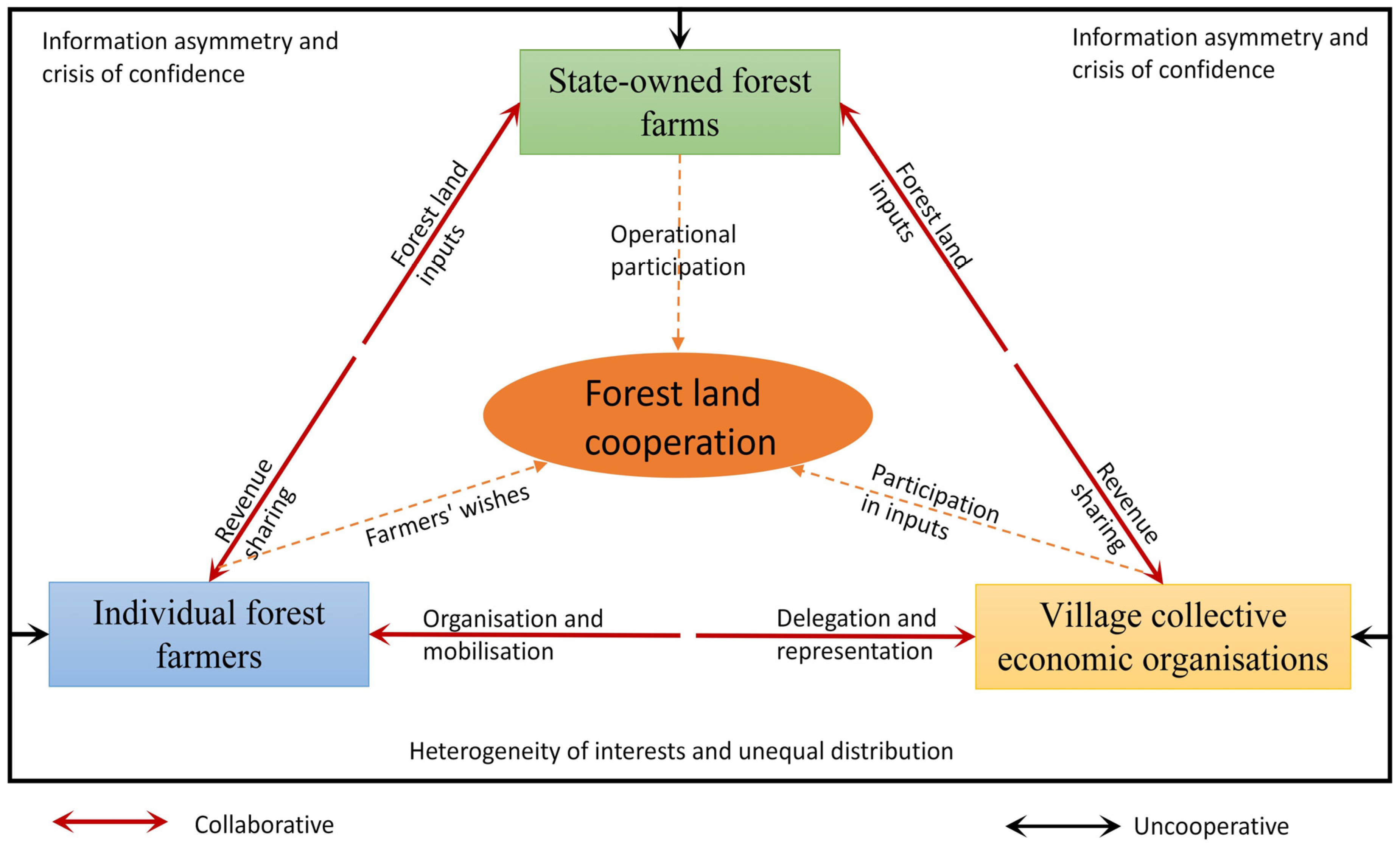
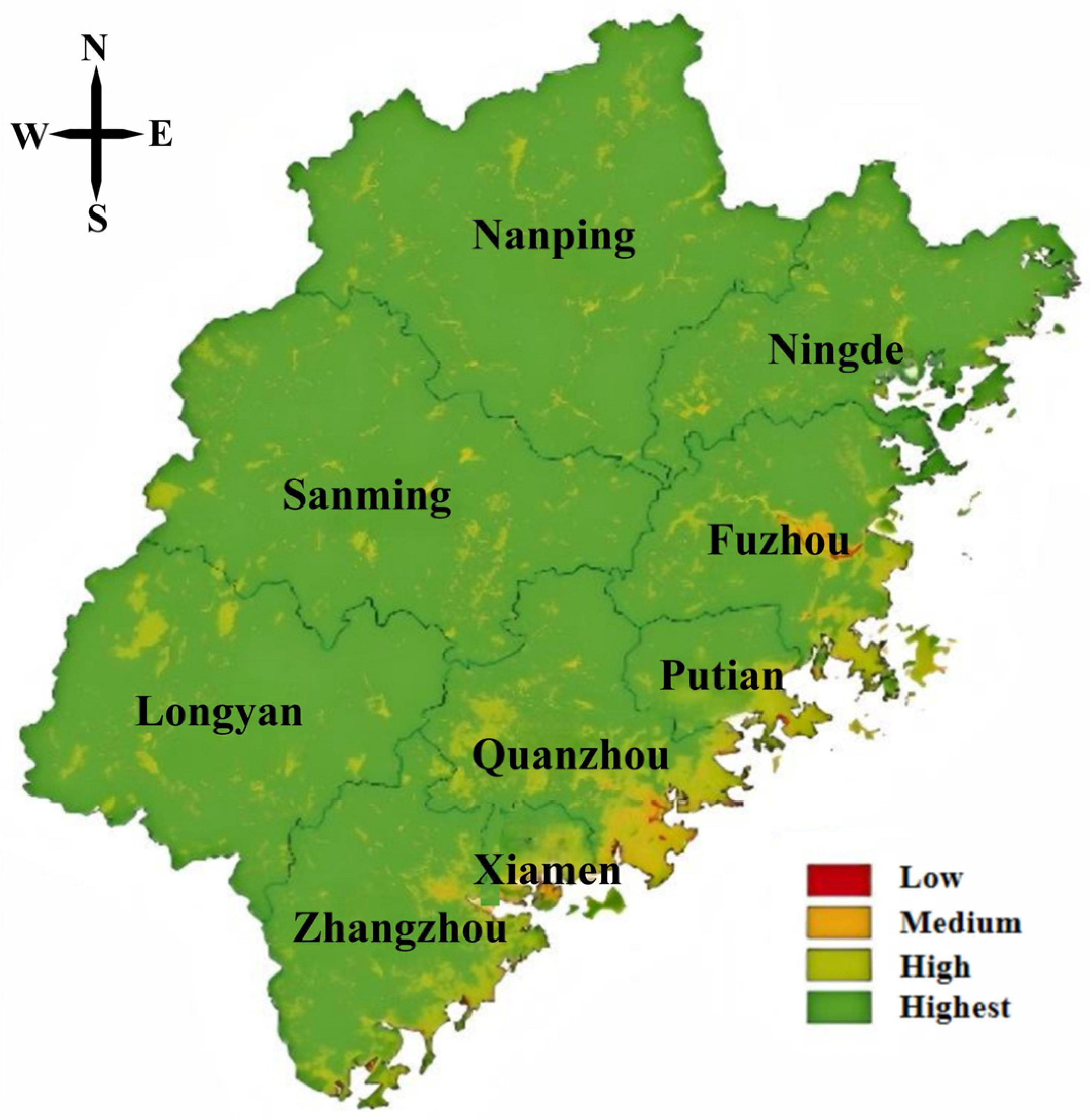
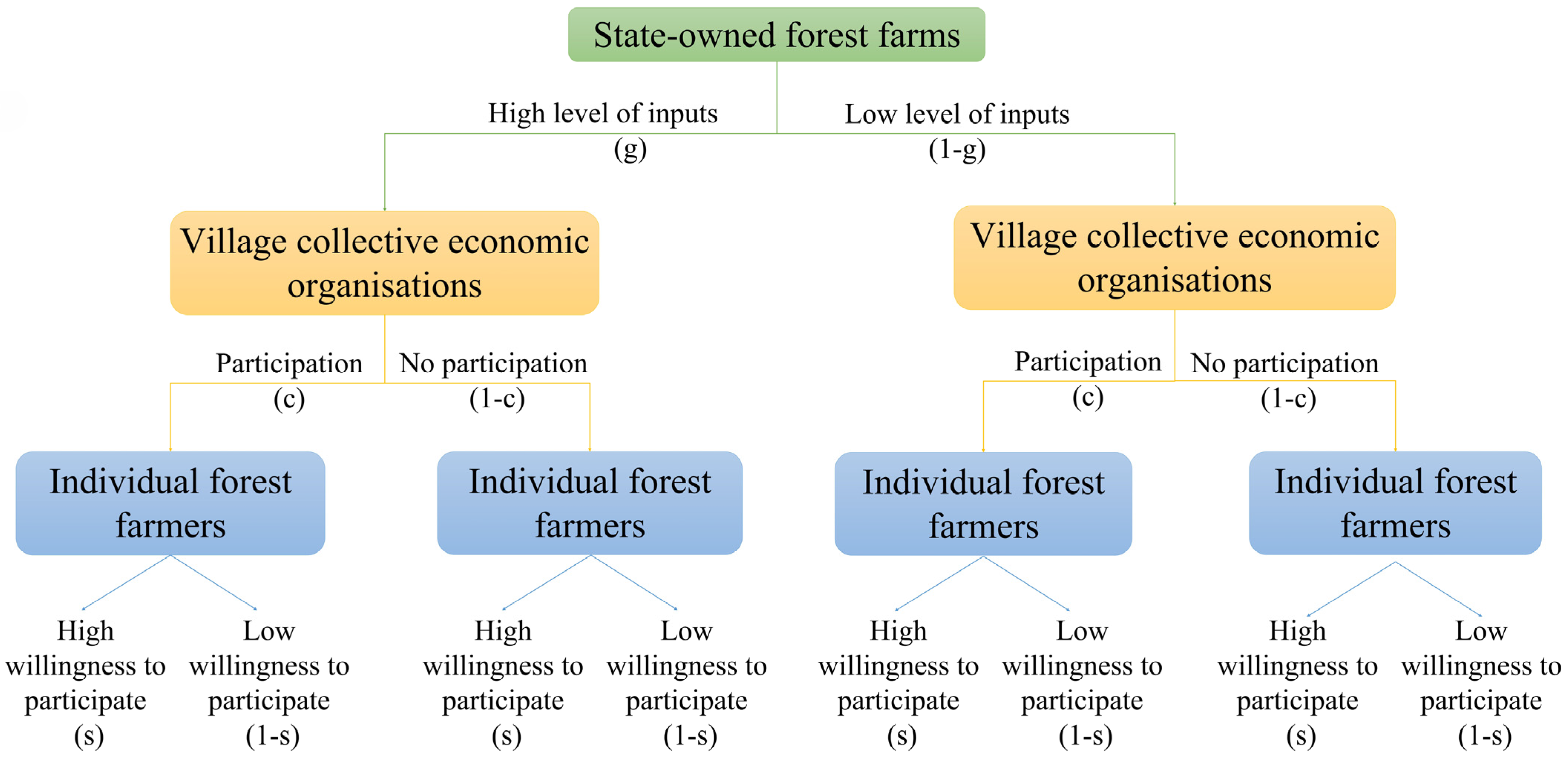
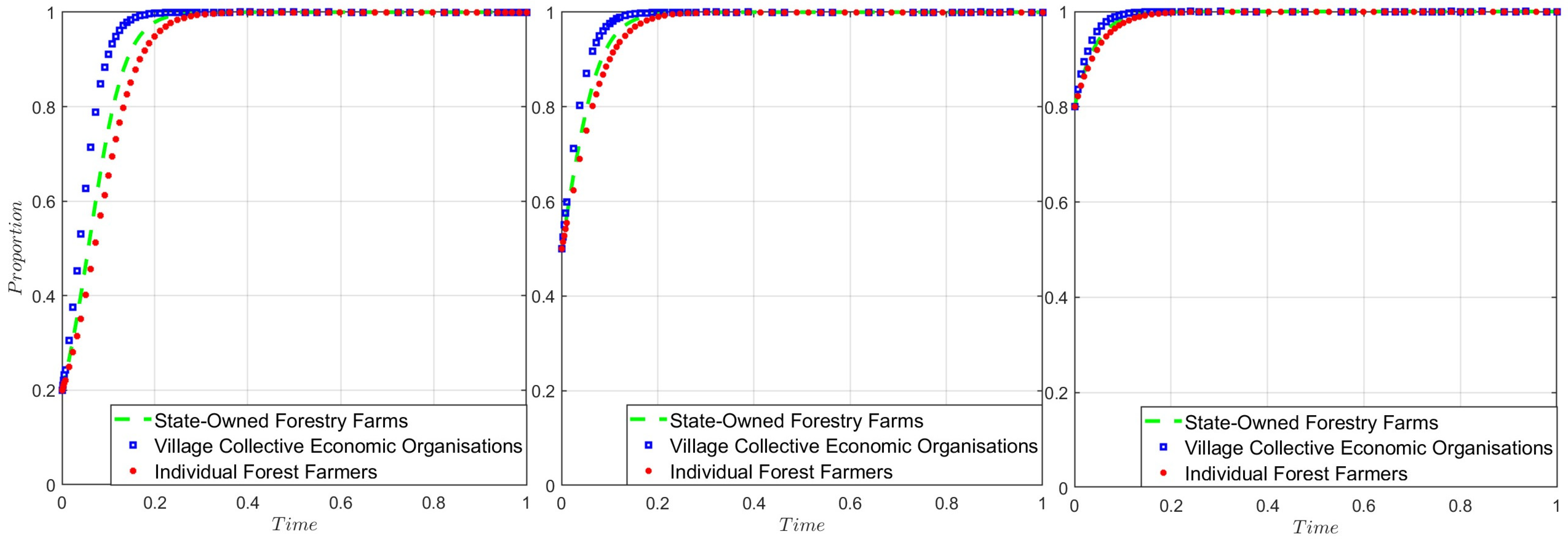

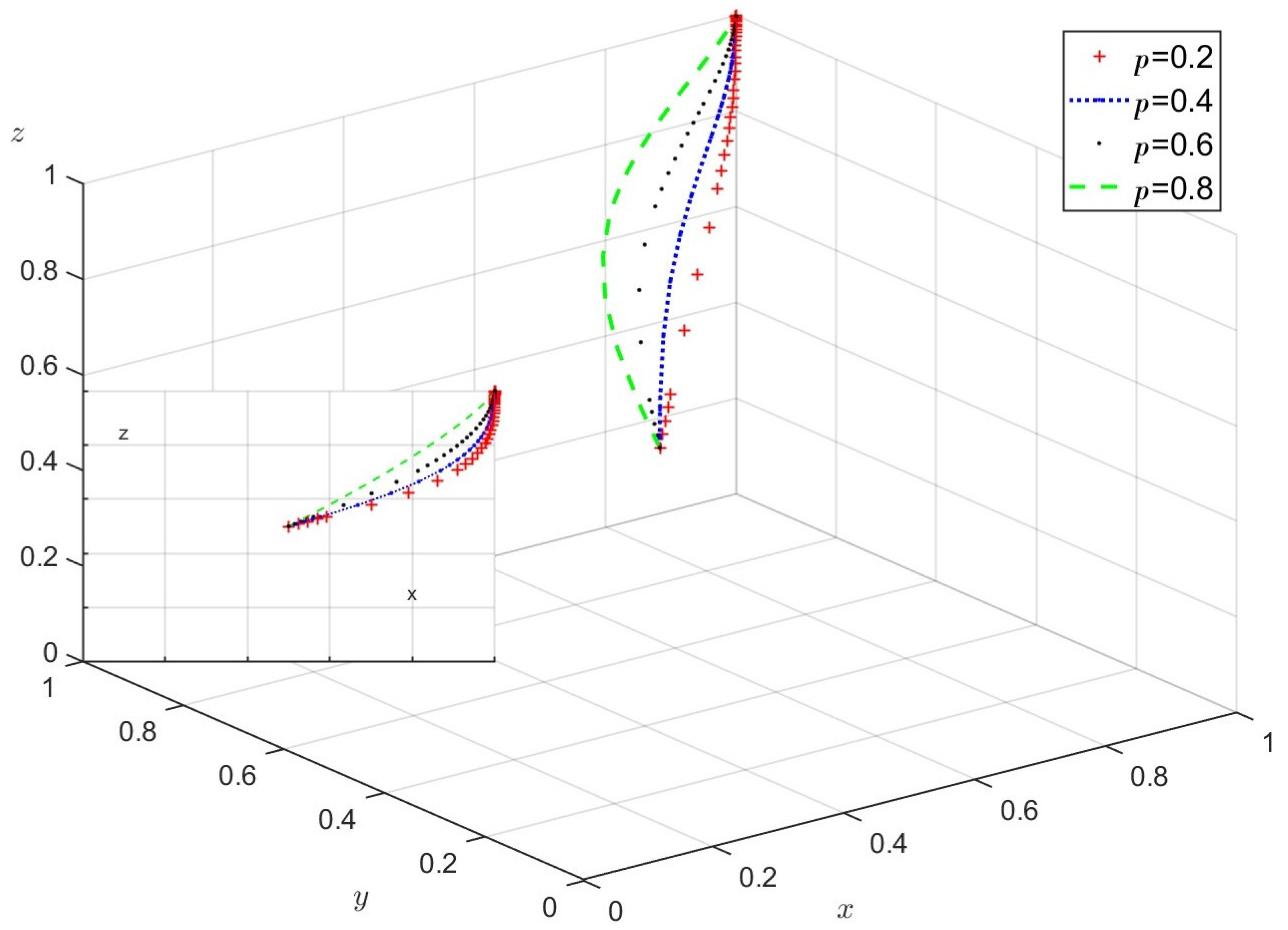
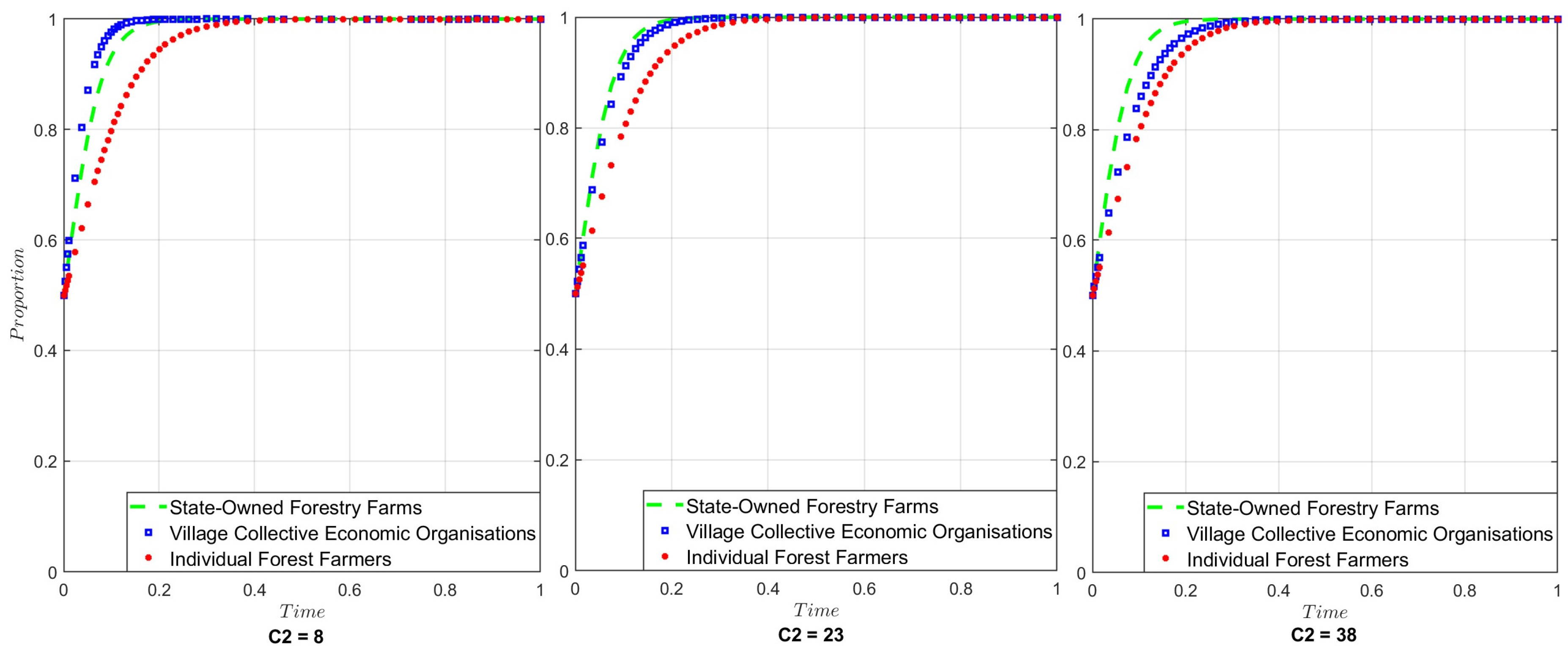

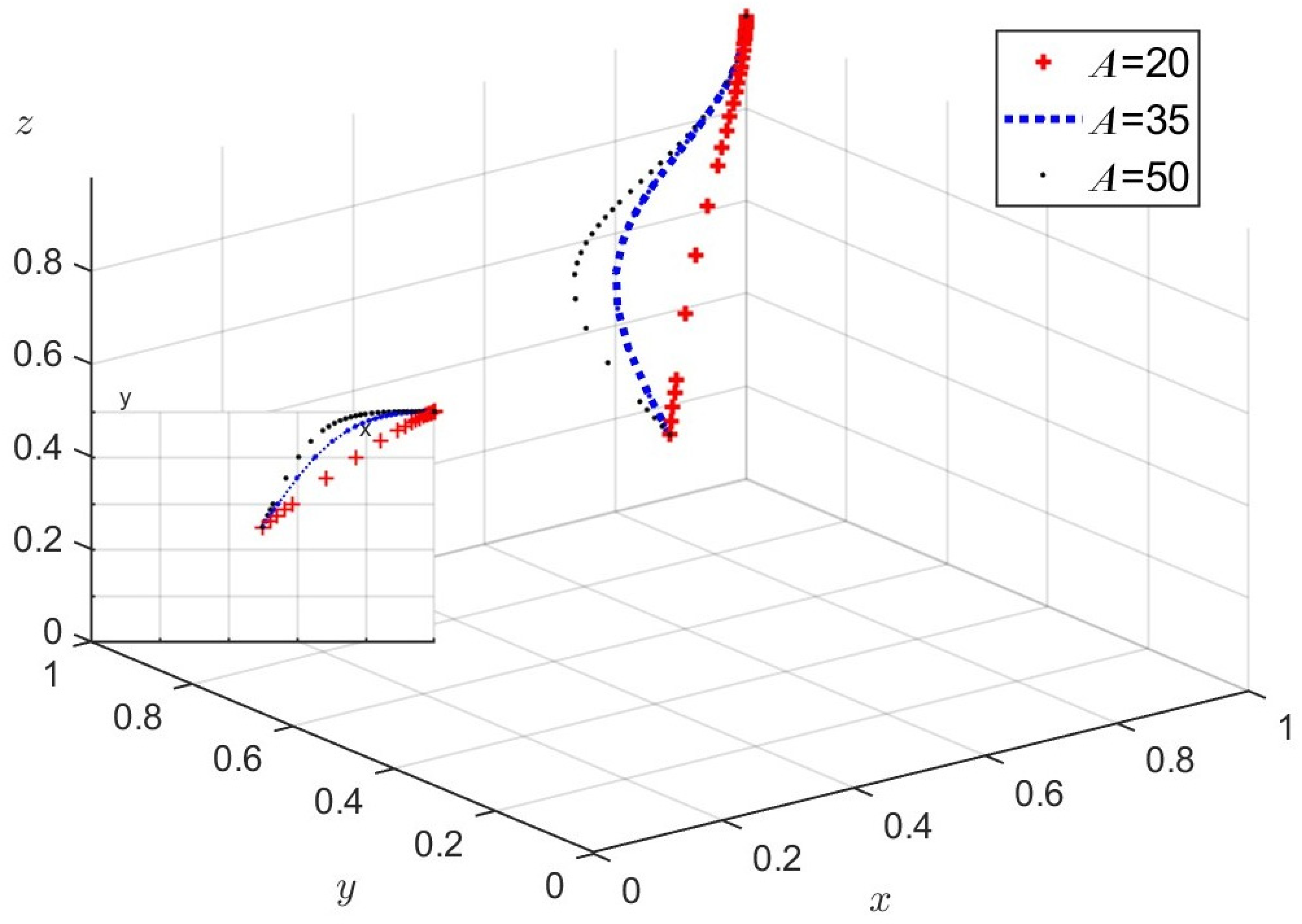
| Parameter | Implication |
|---|---|
| Revenue from the cooperative management of forest land under the forest ticket system | |
| Proportion of the value of forest tickets allocated to state-owned forest farms | |
| Proportion of the value of forest tickets allocated to village collective economic organisations | |
| Proportion of value of forest tickets distributed to individual foresters | |
| Forest business environment: expressed by timber price index. The market price of timber in the year before the implementation of the forest ticket system is taken as the base year, >1 indicates that the forest management environment is favourable, while <1 indicates that the forest management environment is deteriorating. | |
| Probability of state-owned forest farms choosing {high level of input} strategy | |
| Probability of village collective economic organisation choosing {participation} strategy | |
| Probability that individual forest farmers choose {high willingness to participate} strategy | |
| Costs of the high-level input operation of state-owned forest farms, including inputs such as manpower, management costs, etc. | |
| Policy implementation benefits obtained by state-owned forest farms (proceeds from government subsidies and policy incentives received by state-owned forest farms after their participation in forest ticket cooperation) | |
| Degree of low-level input in state-owned forest farms (quantifies the extent of low levels of inputs by analysing the difference in input ratios from the base year through financial data) | |
| Reputation loss due to a failure to maintain good relations with surrounding communities and farmers when state-owned forest farms have low levels of inputs (assessment of the extent of the decline in the reputation of state forest farms through community satisfaction surveys and correlation analyses with the loss of revenue from low inputs) | |
| Loss of individual forest farmers with high willingness to participate when state-owned forest farms have low levels of inputs (difference between foresters’ income from forest tickets and the base year when there was a low level of inputs from state-owned forests) | |
| Costs of village collective economic organisations’ participation in cooperation, including inputs such as publicity and popularisation, cooperation negotiations, and meeting organisation | |
| Additional costs for individual forest farmers with high willingness to participate when village collective economic organisations do not participate in cooperation (analyses the financial cost of additional inputs for foresters through questionnaires and interviews with relevant data) | |
| Loss of weakened social ties with individual forest farmers when village collective economic organisations do not participate in the cooperation. (analysis of changes in foresters’ social trust, willingness to cooperate, and social support when village collective economic organisations are not involved through questionnaires and interviews, and an analysis of correlations with economic losses) | |
| Forest land use fees paid by the state-owned forest farms to village collective economic organisations during the main harvesting of forest trees | |
| Costs when individual forest farmers’ willingness to participate is high, including inputs such as information collection and institutional learning | |
| Degree of inputs when individual forest farmers’ willingness to participate is low (quantification of the extent of inputs in the case of low willingness through the difference between the cost inputs as a proportion of household expenditures and the base year) | |
| Default risk of state-owned forest farms with high level of inputs when individual forest farmers’ willingness to participate is low (correlation analysis based on foresters’ willingness to participate and frequency of defaults through questionnaires and interviews) | |
| Probability of individual forest farmers’ participation in forest ticket trading | |
| Benefits gained by individual forest farmers from forest ticket trading | |
| Proportion of prestige gains through individual forest farmers’ forest ticket trading behaviour when village collective economic organisations participate in cooperation (percentage of transactions in which foresters’ forest ticket transactions were collectively supported through questionnaires or interviews) |
| Strategic Decision | Benefits | ||||
|---|---|---|---|---|---|
| State-Owned Forest Farms (Probability) | Village Collective Economic Organisations (Probability) | Individual Forest Farmers (Probability) | State-Owned Forest Farms | Village Collective Economic Organisations | Individual Forest Farmers |
| ) | |||||
| ) | |||||
| ) | |||||
| ) | |||||
| Equilibrium Point | Eigenvalues of the Jacobi Matrix | Sign of Real Part | Stability | Condition | ||
|---|---|---|---|---|---|---|
| Unstable | ||||||
| Unstable | ||||||
| ESS | ||||||
| Unstable | ||||||
| Unstable | ||||||
| Unstable | ||||||
| ESS | ||||||
| ESS | ||||||
| Dimension | SOTA Methods | The Research in This Paper |
|---|---|---|
| Theoretical Assumptions | Based on finite rationality but mostly assumes subject homogeneity. | Based on limited rationality, emphasising subject heterogeneity (differences in cognitive level and ability to acquire information) and reflecting the incompleteness of the exploration stage. |
| Modelling Approach | Complex networks, stochastic evolution, fractional order models. | Based on the framework of evolutionary game analysis, combining the reward and punishment mechanism with marginal strategy adjustment in the policy case. |
| Application Scenarios | Mature environmental policy or cross-disciplinary cooperation. | Focusing on the emerging forest ticket system, analysing the equilibrium of interests and evolution paths of multiple subjects at the early stage of the policy, emphasising long-term dynamics and policy adaptability. |
| Simulation Technology | MATLAB-based multi-subject numerical simulation. | MATLAB-based multi-subject numerical simulation with simulation values based on real-life cases. |
| Methodological Innovations | Introduction of complex networks or stochastic perturbations to enhance model realism. | Combining the real cases and policy background, exploring the dynamic trial-and-error characteristics of the stage, and revealing the optimisation mechanism of the subject’s strategy. |
Disclaimer/Publisher’s Note: The statements, opinions and data contained in all publications are solely those of the individual author(s) and contributor(s) and not of MDPI and/or the editor(s). MDPI and/or the editor(s) disclaim responsibility for any injury to people or property resulting from any ideas, methods, instructions or products referred to in the content. |
© 2025 by the authors. Licensee MDPI, Basel, Switzerland. This article is an open access article distributed under the terms and conditions of the Creative Commons Attribution (CC BY) license (https://creativecommons.org/licenses/by/4.0/).
Share and Cite
Fei, S.; Han, X.; Wang, W.; Li, H. A Study of the Dynamic Evolution Game of Cooperative Management by Multiple Subjects Under the Forest Ticket System. Forests 2025, 16, 534. https://doi.org/10.3390/f16030534
Fei S, Han X, Wang W, Li H. A Study of the Dynamic Evolution Game of Cooperative Management by Multiple Subjects Under the Forest Ticket System. Forests. 2025; 16(3):534. https://doi.org/10.3390/f16030534
Chicago/Turabian StyleFei, Siyu, Xiao Han, Wen Wang, and Hongxun Li. 2025. "A Study of the Dynamic Evolution Game of Cooperative Management by Multiple Subjects Under the Forest Ticket System" Forests 16, no. 3: 534. https://doi.org/10.3390/f16030534
APA StyleFei, S., Han, X., Wang, W., & Li, H. (2025). A Study of the Dynamic Evolution Game of Cooperative Management by Multiple Subjects Under the Forest Ticket System. Forests, 16(3), 534. https://doi.org/10.3390/f16030534







